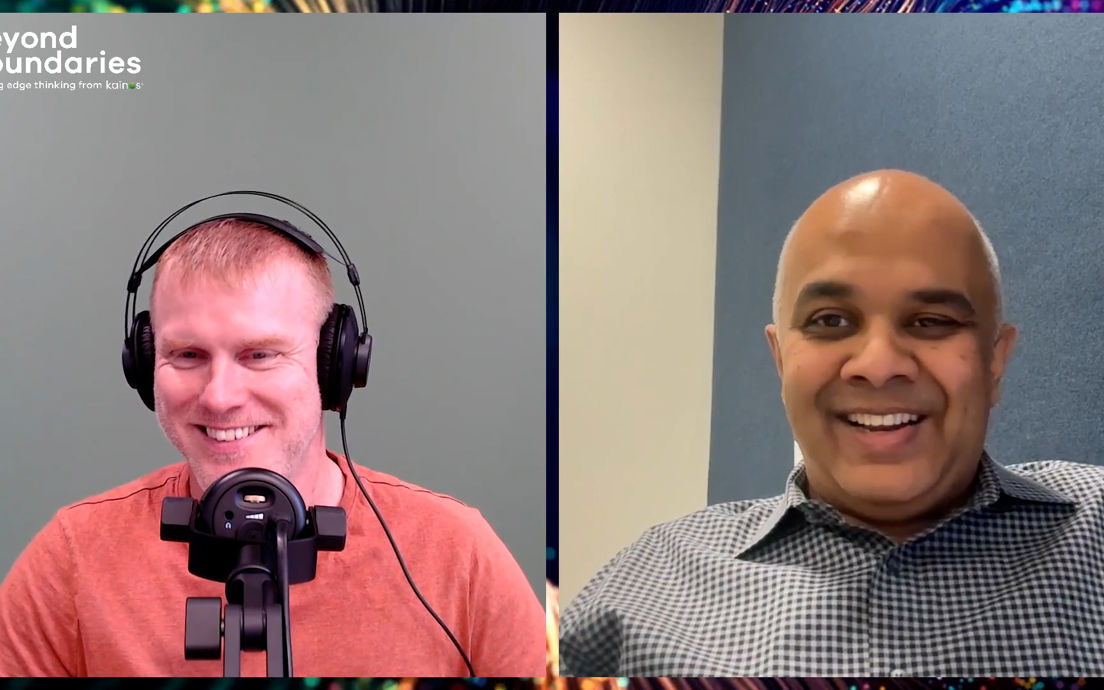Beyond automation: How leaders can design the future workforce
As AI agents move beyond simple automation into decision-making, collaboration and customer engagement, organisations face a fundamental shift. This isn't just about deploying new technology - it's about redesigning work itself. And for business leaders, the challenge isn't technical; it's human.
In the season finale of the Beyond Boundaries Podcast, Gareth Workman, Chief AI Officer at Kainos, is joined by Mohan Rajagopalan, Senior Principal Product Manager at Workday, to explore what it really means to build a workforce where humans and AI work side by side - by design, not by accident.
Early days with enormous potential
Despite the pace of AI headlines, both speakers agree we're still in the foothills of what's possible. "We really don't know all these primitives out there about agents, about tools, about how they're being built. We're in the early innings," Mohan explains. "So we can all hypothesise and evangelise, but we're learning every day."
Gareth frames this as an opportunity to "remove some of the tedium from our lives" - acknowledging that most people's to-do lists are always too long, with high-value work often out of reach because they're "trying to keep up with the pace."
The focus should be on collaboration: "How can we get these automated machines, agents, to work alongside our workers today to make their lives better? To focus on the work they're passionate about," Mohan adds.

Where AI agents deliver immediate value
The most tangible results are emerging in areas with structured data and labour-intensive processes. Mohan points to legal contract analysis as an example: "It really is where it would take a human too long to read that and too tedious, but we're able to use the power of compute against that problem."
The key is identifying areas where AI can process vast amounts of information that would be overwhelming for humans, but where the underlying structure and context are well-defined.
Rethinking growth, not just costs
Perhaps the most important mindset shift is moving beyond cost reduction. "AI is not a story of cost savings," Mohan emphasises. "AI is a story of being able to reinvest in growth areas of your business and growth areas of your employees."
This reframing changes how organisations approach adoption - from asking "how can we cut costs?" to "how can we reinvest these savings into upskilling our teams and exploring new opportunities?"
The importance of patience and process
Both speakers stress the need for patience - but not passive waiting. "We will have to be patient with the machines," Mohan explains, while Gareth warns against the "fear of missing out" that "drives a race to go somewhere" without figuring out the destination first.
This patience extends to understanding that businesses will look different in future. "There's no way to build something and forget about it," Mohan warns. "So make sure you have a plan to maintain it, to update it. You're understanding that because how we see our businesses today are not how our businesses will run tomorrow."
The solution? "Walk before you can run," as Gareth puts it, building that "flywheel effect" through deliberate implementation: start small, show early ROI, then scale systematically. This means moving beyond viewing AI as a separate initiative to embedding it in how work gets designed and delivered.
Success also requires the right cultural foundations. As Mohan puts it: "Trying to do a large scale transformation across thousands to, in some of our customer base, hundreds of thousands of employees is just very difficult. So start off with a business unit, start out with a team."

Setting the right guardrails
When it comes to scaling, Mohan uses his sandbox analogy: know the parameters, set the walls, then "just be ready to be agile and move with it." It's about enabling safe experimentation while maintaining oversight.
Gareth reinforces this need for "deliberate thought process to think the journey through from the outset" rather than just activating and seeing what happens.
Humans remain central
Throughout the conversation, both return to a fundamental truth: "There's no business where machines are gonna run the day," Mohan states. "Humans really have the knowledge, the context, the empathy, the skill set to drive the growth and the agents are here just to support that in a collaborative manner."
What leaders should do now
- Start with structured, labour-intensive problems where AI can process information that's "too dense to get through"
- Reframe AI as growth investment - reinvest savings into people and new opportunities
- Walk before you run - pilot programmes, early wins, then systematic scaling
- Set clear guardrails while remaining agile and ready to adapt
- Plan the full journey from onboarding to monitoring to retiring agents
- Stay patient but purposeful - we're in early stages, but the potential is enormous
- Keep humans at the centre - focus on collaboration and augmentation, not replacement

S1 E6: Beyond automation: Designing the future workforce
In episode 6, Gareth Workman and Workday's Mohan Rajagopalan explore how AI agents are reshaping work itself - from pilot programmes to sustainable transformation that keeps humans at the centre.
Never miss an episode
Sign up for episode reminders, exclusive thought leadership and practical advice to navigate AI’s biggest challenges.
